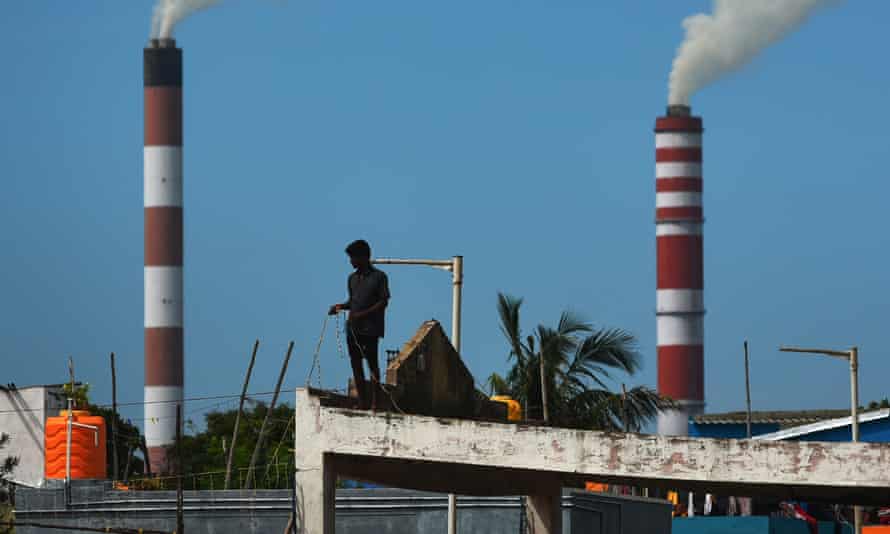India is facing a looming power crisis, as stocks of coal in power plants have fallen to unprecedentedly low levels and states are warning of power blackouts.
States across India have issued panicked warnings that coal supplies to thermal power plants, which convert heat from coal to electricity, are running perilously low.
According to data from the Central Electricity Authority of India, nearly 80% of the country’s coal-fired plants were in the critical, or “supercritical” stage, meaning their stocks could run out in less than five days.
Over the weekend, Delhi’s chief minister, Arvind Kejriwal, wrote to the prime minister, Narendra Modi, that the capital “could face a blackout” if power stations did not receive more coal.
States including Rajasthan, Jharkhand and Bihar have been experiencing power cuts lasting up to 14 hours.
Maharashtra shut down 13 thermal power plants and urged people to use electricity sparingly, and in Punjab three power plants halted production. Scheduled power cuts introduced in Punjab, lasting up to six hours at a time, have prompted protests.
However, experts have emphasised that the power issues are not due to a shortage of domestic coal production, as some have reported.
Over the past two decades, domestic coal production in India has continued to rise exponentially, though there was a minor dip in production of less than 1% from 2019 to 2020 due to the pandemic.
Energy providers and India’s state-owned coal producer, Coal India Limited, have instead been accused of failing to stockpile sufficient amounts to meet the predicted rise in demand.
“The current crisis is not manifested by shortage of coal mining capacity, but instead it is caused due to improper foresight, planning and stocking of coal by power generators and energy regulator in the country,” said Sunil Dahiya, an analyst at the Centre for Research on Energy and Clean Air.
This year’s heavy monsoon rains have also been blamed for affecting domestic coal mining due to flooding and impeding the dispatch of coal from the mines.
While this is no different from every year, more coal is usually imported to bridge the gap in production. But due to a global energy crisis, which has seen international prices hit record highs, it has been more of a financial challenge to import more coal, leading to greater shortages than usual.
Vibhuti Garg, lead India economist for the Institute for Energy Economics and Financial Analysis, said that there had been a significant growth in electricity demand recently, as India had re-emerged from the Covid lockdown, but added that this had been anticipated months ago, so should not have taken power companies by surprise.
“Various stakeholders are to be blamed for the situation,” said Garg, who described the situation as “scary but likely to get better soon”.
“Developers were playing safe, thinking that there was a high chance of another Covid wave hitting around this time of the year which would suppress demand. So they didn’t do enough to stock coal at their end.
“So, while there was availability of coal in the last few months, developers were not maintaining enough stock at their end, leading to a crisis situation now.”
Garg said that over the past year “renewable energy installation also slowed down” and that, if the Indian government had focused on increasing the capacity of renewables such as solar, wind and hydro, “the increased demand could have been met through renewable energy and this crisis could have been averted”.
Seeking to allay fears around the power shortages, India’s minister for power, RK Singh, said that “panic has been unnecessarily created about coal shortages”.
Coal minister Pralhad Joshi blamed heavy rains and the high price of international coal for disrupting supply but insisted that in “another three to four days, things will be alright”.
However, there are concerns that the shortages will be used by to justify pushing more domestic coal production, with some state governments already putting on the pressure for expedited clearance for new coalmines in protected areas.
India already has plans to boost its domestic coal production to 1bn tons by 2024.
“The situation is used by few stakeholders to push forward more opening up of coalmines citing the reason as low coal availability but that’s not true at all,” said Dahiya.
Any further expansion will mostly affect India’s tribal communities who live in the forests which cover India’s largest coal reserves, and who have already born the brunt of the environmental damage of coal mining.
If India is to meet its climate targets in the coming years, the country will also need to wean itself off coal, which currently powers almost 70% of its electricity.
“I think the government is using this as an opportunity to push for more coal mining or coal-based power generation,” said Garg. “But we should avoid investing money in assets which will become stranded.
“Coal based generation is expensive and the prices will further increase. On the other hand, renewable energy generation is cheap and prices are likely to go down further.”





